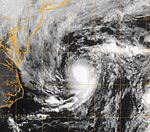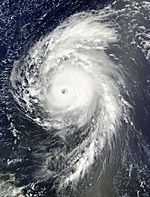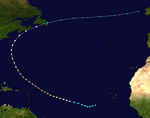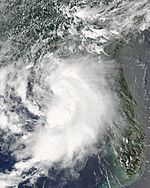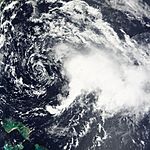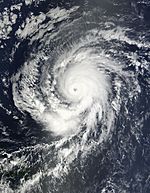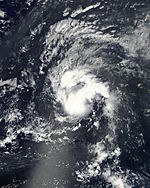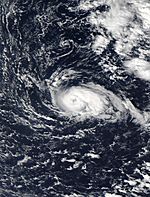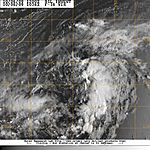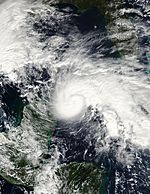The 2009 Atlantic hurricane season was when tropical storms and hurricanes formed in the Atlantic Ocean during that year. It officially ran from June 1 to November 30, 2009. However, the first storm, Tropical Depression One, actually formed a bit early on May 28. Interestingly, there were no storms at all in June or July, which hadn't happened since 1992. Overall, the season had 2 tropical depressions, 7 tropical storms, and 3 hurricanes. Two of these hurricanes were very strong, known as major hurricanes.
Storms of 2009
Tropical Depression One
| Tropical depression (SSHS) |
|
|
| Duration |
May 28 – May 29 |
| Intensity |
35 mph (55 km/h) (1-min), 1006 mbar (hPa) |
On May 28, a small storm formed near the coast of North Carolina. It became a tropical depression, which was called "One". The National Hurricane Center thought it might get stronger. However, the water was too cold, so it didn't get enough energy. It weakened and disappeared the very next day.
Tropical Storm Ana
| Tropical storm (SSHS) |
|
|
| Duration |
August 11 – August 17 |
| Intensity |
45 mph (75 km/h) (1-min), 1003 mbar (hPa) |
Tropical Depression Two formed on August 11, south of Cape Verde. It moved west and faded away by August 13. But on August 15, the storm's remains reformed. Tropical Depression Two quickly became Tropical Storm Ana. The storm kept moving west towards the Leeward Islands. A few days later, as it neared the islands, it weakened back into a tropical depression. Ana hit Dominica on August 16 and then disappeared the next day.
Hurricane Bill
| Category 4 hurricane (SSHS) |
|
|
| Duration |
August 15 – August 24 |
| Intensity |
135 mph (215 km/h) (1-min), 943 mbar (hPa) |
On August 15, Tropical Depression Three formed and quickly grew into Tropical Storm Bill. By August 17, Tropical Storm Bill became Hurricane Bill. On August 18, Hurricane Bill turned into a major hurricane, reaching Category 3 strength. It quickly became a Category 4 hurricane on August 19. However, it weakened back to Category 3 on August 20.
Hurricane Bill continued to weaken, becoming a Category 2 on August 21 and then a Category 1 the next day. As a Category 1 hurricane, Bill came close to hitting Nova Scotia. Late on August 23, Bill made landfall in Newfoundland. It then changed into a non-tropical storm the next day. Its leftover parts later affected the United Kingdom.
Tropical Storm Claudette
| Tropical storm (SSHS) |
|
|
| Duration |
August 16 – August 18 |
| Intensity |
50 mph (85 km/h) (1-min), 1006 mbar (hPa) |
Tropical Storm Claudette started in the Gulf of Mexico as Tropical Depression Four. This happened early on August 16. Later that same day, it strengthened into Tropical Storm Claudette. Early the next morning, Claudette hit Santa Rosa Island, Florida. Tropical Storm Claudette then weakened and disappeared by August 18.
Tropical Storm Danny
| Tropical storm (SSHS) |
|
|
| Duration |
August 26 – August 29 |
| Intensity |
70 mph (110 km/h) (1-min), 1006 mbar (hPa) |
Tropical Storm Danny formed north of Puerto Rico on August 26. Danny's strongest winds reached 60 miles per hour. Danny did not become a hurricane. Instead, it moved towards North Carolina as a weak tropical storm. On August 29, Danny weakened into a depression and lost its clouds to another storm. Danny did not reach North Carolina before it fell apart. Sadly, Danny caused the death of a boy in North Carolina due to dangerous rip currents.
Tropical Storm Erika
| Tropical storm (SSHS) |
|
|
| Duration |
September 1 – September 3 |
| Intensity |
60 mph (95 km/h) (1-min), 1004 mbar (hPa) |
Tropical Storm Erika formed on September 1. It was named Tropical Storm Erika right away, meaning it was never a tropical depression. Tropical Storm Erika mostly moved west during its short life. On September 2, Tropical Storm Erika made landfall in Guadeloupe. Tropical Storm Erika then weakened to a tropical depression and later just a leftover low on September 3. The leftover storm brought some rain to the northern islands of the Caribbean Sea.
Hurricane Fred
| Category 3 hurricane (SSHS) |
|
|
| Duration |
September 7 – September 12 |
| Intensity |
120 mph (195 km/h) (1-min), 985 mbar (hPa) |
Tropical Depression Seven formed on September 7 south of the Cape Verde Islands. Later that same day, it became a tropical storm and was named Fred. Early the next day, Tropical Storm Fred became Hurricane Fred, which was the second hurricane of the season. Hurricane Fred then became a major hurricane, reaching Category 3 strength.
Fred slowly weakened after becoming a Category 3 hurricane. On September 12, while it was still a tropical storm, Fred turned into a leftover low and was no longer a tropical storm.
Tropical Depression Eight
| Tropical depression (SSHS) |
|
|
| Duration |
September 25 – September 26 |
| Intensity |
35 mph (55 km/h) (1-min), 1008 mbar (hPa) |
Tropical Depression Eight formed near Cape Verde on September 25. Experts thought it might become a tropical storm, but it did not. Instead, Tropical Depression Eight turned into a tropical wave on September 26. It was no longer a tropical depression after that.
Tropical Storm Grace
| Tropical storm (SSHS) |
|
|
| Duration |
October 4 – October 5 |
| Intensity |
70 mph (110 km/h) (1-min), 989 mbar (hPa) |
Tropical Storm Grace became a tropical storm late on October 4. It was also never a tropical depression as it formed. Tropical Storm Grace moved towards Ireland. However, it merged with another weather system on October 5, and Grace was no longer a tropical storm. The remains of the storm affected Ireland and the United Kingdom.
Tropical Storm Henri
| Tropical storm (SSHS) |
|
|
| Duration |
October 6 – October 8 |
| Intensity |
50 mph (85 km/h) (1-min), 1005 mbar (hPa) |
Tropical Storm Henri was a weak storm that mostly stayed out in the ocean. It formed from a tropical wave on October 6 while moving northwest across the Atlantic. The next day, strong winds around the storm caused it to weaken into a remnant low. Its remains were last seen near Cuba. The storm did not get close to any land and did not cause any damage.
Hurricane Ida
| Category 2 hurricane (SSHS) |
|
|
| Duration |
November 4 – November 10 |
| Intensity |
105 mph (165 km/h) (1-min), 976 mbar (hPa) |
On November 4, Tropical Depression Eleven started in the Caribbean Sea. Later that same day, it became a tropical storm and was named "Ida". Ida became a hurricane just before it hit land on November 5. Ida quickly weakened over land and was a depression by the end of the day.
On November 6, Ida moved back into the Caribbean Sea, just north of Honduras. Ida became a tropical storm again on November 7. Ida later became a hurricane once more, but then weakened back to a tropical storm on November 9. Ida made landfall in Alabama on November 10. The storm died only about 4 hours later. The remains of Ida turned into a powerful nor'easter storm that caused 9 deaths. Hurricane Ida also caused about $5.6 million in damage.
Storm Names of 2009
The names below were used for storms that formed in the North Atlantic in 2009. This is the same list that was used in the 2003 season. However, the names "Fred", "Ida", and "Joaquin" were new. In 2003, those three names were Fabian, Isabel, and Juan. Their names were removed from the list because they caused a lot of damage in 2003.
- Ana
- Bill
- Claudette
- Danny
- Erika
- Fred
- Grace
|
- Henri
- Ida
- Joaquin (unused)
- Kate (unused)
- Larry (unused)
- Mindy (unused)
- Nicholas (unused)
|
- Odette (unused)
- Peter (unused)
- Rose (unused)
- Sam (unused)
- Teresa (unused)
- Victor (unused)
- Wanda (unused)
|
Related Information
|
Tropical cyclones of the 2009 Atlantic hurricane season
|
|
|
|
|
|
Images for kids
-
Satellite image showing Tropical Storms Ana (center), Bill (right), and Claudette (left) on August 16.
See also
 In Spanish: Temporada de huracanes en el Atlántico de 2009 para niños
In Spanish: Temporada de huracanes en el Atlántico de 2009 para niños
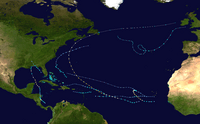
 In Spanish: Temporada de huracanes en el Atlántico de 2009 para niños
In Spanish: Temporada de huracanes en el Atlántico de 2009 para niños

